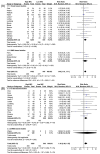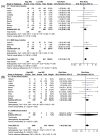High vancomycin minimum inhibitory concentration and clinical outcomes in adults with methicillin-resistant Staphylococcus aureus infections: a meta-analysis
- PMID: 23089040
- PMCID: PMC3780595
- DOI: 10.1016/j.ijid.2012.08.005
High vancomycin minimum inhibitory concentration and clinical outcomes in adults with methicillin-resistant Staphylococcus aureus infections: a meta-analysis
Abstract
Background: Patients with methicillin-resistant Staphylococcus aureus (MRSA) infections caused by isolates with a high but 'susceptible' minimum inhibitory concentration (MIC) to vancomycin may suffer poor outcomes. The aim of this study was to determine the association of high compared to low vancomycin MICs and clinical outcomes (treatment failure and mortality) in patients with MRSA infections.
Methods: PubMed, the Cochrane Library, and electronic abstracts from meetings were queried from January 2000 to July 2010. Two reviewers independently screened titles and abstracts of studies evaluating outcomes of patients with MRSA infections, using broth microdilution (BMD) or the Etest to determine MIC, for full-text review. Patients participating in included studies were classified into two mutually exclusive groups: high MIC or low MIC. High MIC was defined as MIC ≥1mg/l by BMD or ≥1.5mg/l by Etest. Study-defined failure and mortality were assessed in each group.
Results: Fourteen publications and six electronic abstracts met the inclusion criteria, with 2439 patients (1492 high MIC and 947 low MIC). There was no evidence of publication bias or heterogeneity. An increased risk of failure was observed in the high MIC group compared to the low MIC group (summary risk ratio (RR) 1.40, 95% confidence interval (CI) 1.15-1.71). The overall mortality risk was greater in the high MIC group than in the low MIC group (summary RR 1.42, 95% CI 1.08-1.87). Sensitivity analyses showed similar findings for failure (summary RR 1.37, 95% CI 1.09-1.73) and mortality (summary RR 1.46, 95% CI 1.06-2.01) for patients with bacteremia. The study quality was poor-to-moderate, and study-defined endpoints were variable.
Conclusions: A susceptible but high MIC to vancomycin is associated with increased mortality and treatment failure among patients with MRSA infections.
Copyright © 2012 International Society for Infectious Diseases. Published by Elsevier Ltd. All rights reserved.
Figures




References
-
- Moellering RC., Jr Vancomycin: a 50-year reassessment. Clin Infect Dis. 2006;42(Suppl 1):S3–4. - PubMed
-
- Ploy MC, Grelaud C, Martin C, de Lumley L, Denis F. First clinical isolate of vancomycin-intermediate Staphylococcus aureus in a French hospital. Lancet. 1998;351:1212. - PubMed
-
- US Centers for Disease Control and Prevention . CDC reminds clinical laboratories and healthcare infection preventionists of their role in the search and containment of vancomycin-resistant Staphylococcus aureus (VRSA) CDC; Atlanta, GA: [accessed April 24, 2011]. 2011. Available at: http://www.cdc.gov/HAI/settings/lab/vrsa_lab_search_containment.html.
-
- Clinical and Laboratory Standards Institute . Performance standards for antimicrobial susceptibility testing. CLSI approved standard M100-S16. CLSI; Wayne, PA: 2006.
-
- Tenover FC, Moellering RC., Jr. The rationale for revising the Clinical and Laboratory Standards Institute vancomycin minimal inhibitory concentration interpretive criteria for Staphylococcus aureus. Clin Infect Dis. 2007;44:1208–15. - PubMed
Publication types
MeSH terms
Substances
Grants and funding
LinkOut - more resources
Full Text Sources
Other Literature Sources
Medical
Miscellaneous

